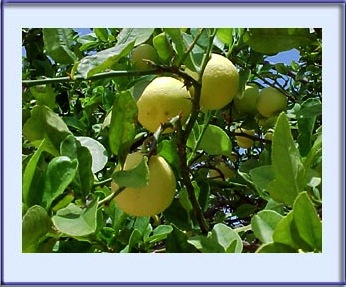
Growing Citrus Fruit in Canberra and other cold climates
The most commonly planted citrus are lemon trees, especially ‘Meyer’, which is cold-hardy but less acid than ‘Eureka’ or ‘Lisbon’. Eureka and Lisbon are a little more frost-tender than Meyer, but still widely grown in Canberra. Most citrus, including Meyer, will show some signs of cold damage by the end of winter (leaves dull yellow) but it’s best to leave that foliage intact until the tree is actively growing in spring. You can then tidy up the tree by pruning off the affected foliage.
‘Meyer’ lemons are smaller trees and make good tub specimens. They mature in late autumn and if picked and stored, will keep you in lemons for many months. Cut with a piece of stalk attached and they will last longer. ‘Eureka’ and ‘Lisbon’ lemons will grow and produce a good crops if they are planted in a protected spot and given some cover during the winter months when establishing.
Meyer lemons bear well in Canberra and have fruit on virtually all year round.
Cumquat and Calamondin are small, attractive trees grown mainly for their ornamental value (excellent tub specimens). Their attractive bitter fruits make excellent marmalade and preserves.
In grapefruit the variety ‘Wheeny’ appears to be more cold-tolerant than the popular ‘Marshes Seedless’.
Dwarf citrus trees, ideal for either small gardens or pots, are now available. These are exactly the same as the larger trees, but are controlled by a dwarfing rootstock called ‘Flying Dragons’ and will grow to about half the size of the big trees. Those which will grow locally are Meyer ‘Lots a’ Lemons’, dwarf mandarin ‘Emperor’ and dwarf lime ‘Tahiti’ and ‘Sub Lime’
Most citrus plants are from warm-temperate to sub-tropical climates with high rainfall so siting the plant is important. Generally they should be planted in a warm protected location, eg a north-facing wall, under the eaves of the house, on a protected deck or in a tub on castors that can be moved to a warmer spot during the frosty months. It is likely that some of the leaves will be damaged by winter frosts but don’t worry. Leave the affected leaves to protect others beneath and then trim them off in spring. Don’t apply fertiliser in any form during winter, and wait till the frosts are over before you feed your tree. Add about a handful of an organic based fertiliser per square metre once a season and cover with mulch. This will do more than feed the plants; it will also encourage earthworm and soil microbial activity.
All citrus prefer a free draining sandy to loamy soil and do not like waterlogged soil. A good mulch of decayed organic matter is essential, particularly for winter. Regular watering especially in summer is another essential as they are shallow rooted. Because they are evergreen, occasional watering in winter will be necessary if they are grown under the eaves of buildings.
Planting is best done when the danger of frost has passed and the soil is warming (late October to early November is ideal). Planting in autumn may result in losses as trees will have little time to acclimatise before winter.
Some points to bear in mind:
- Apart from frost damage, the most likely pest problems are aphids and caterpillars. Hand picking is the best control for the caterpillars. Natural predators may get the aphids but if you have to spray do not do this close to harvest.
- Mid to late spring is when Bronze Orange bugs (Stink bugs) can appear. The young ones are small and green, the next stage are bright orange and the adults are like large shiny cockroaches. They all cause flower and fruit drop by sucking sap and are quite smelly. Removing by hand and dropping into a bucket of hot water is an effective way of removing them, providing the tree is not too big, but wear protective goggles and clothing as the fluid they squirt is caustic and can be particularly painful to the eyes.
- Scale insects are sometimes evident, and your first sign of an infestation may be increased activity on the tree and perhaps black sooty mould. Small numbers can be rubbed off. Regular sprays with soapy water or pest oil with control the scale and once the scale is controlled the sooty mould will not be a problem.
- Snails and slugs like the leaves. The usual baits won’t work as they feed up in the canopy. Hand pick and use rough mulches as a barrier. An adhesive copper strip encircling the trunk may be useful for snails will not cross over the copper.
- Nitrogen, magnesium and iron deficiencies cause leaf distortions. Correct by applying a complete citrus food in spring and again in autumn.
For those who grow only Australian plants, you too can have a citrus tree. Consider the Finger Lime (Microcitrus australasica). This plant is an understorey tree in SE Queensland and northern NSW, which would naturally grow to 10 m. They have prominent thorns and contain some seeds. Don’t be deterred by the origin and ultimate size, for it is comparable with Meyer lemons for frost tolerance and will make an interesting pot specimen. The fruit, normally green and cylindrical in shape, is up to around 10 cm long and only about 2–3 cm wide with acidic juice not unlike a lime. Juice vesicles are compressed and when the skin of the fruit is cut, they will burst out, enabling them to be used in creative ways for cooking. They are a surprising addition to salad dressings and whole fruit can be frozen without destroying flavour or texture on thawing. ‘Rick’s Red’ is a cultivar with purplish red skin with red flesh.







